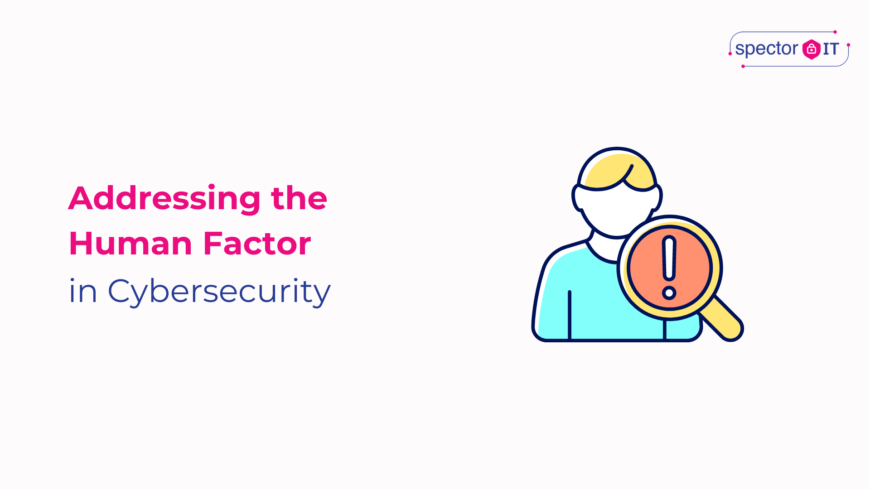
Addressing the Human Factor in Cybersecurity
Cybersecurity isn’t just about firewalls or software—it starts and ends with your people. In fact, four out of five cyber‑incidents now begin with human error. Verizon’s Data Breach Investigations Report reveals that 74% of breaches involve a human element, like clicking phishing links, reusing weak passwords, mis-sending sensitive emails, or insider mistakes.
That’s why putting the human factor in cybersecurity at the heart of your strategy is critical. By empowering your teams and adjusting your processes, you can turn this often-overlooked risk into a strength.
Why the Human Factor in Cybersecurity Is Your Top Risk
1. Contemporary Threats: Why People Mistakes Fuel 2025 Incidents
The nature of work today—remote setups, SaaS overload, and AI-generated scams—is making mistakes more common:
-
Hybrid work means staff switch between office Wi-Fi, personal routers, and mobile hotspots, expanding entry points for attackers.
-
App fatigue leads people to jot down passwords or reuse them.
-
Deepfake phishing via voice or email is now easy to produce & hard to detect.
These trends underline why the human factor in cybersecurity remains the weakest—and most fixable—link.
2. How Hackers Exploit Basic Human Traits
Criminals tap into natural instincts. Misplaced trust influences mistakes. Try this real‑life tactic:
-
Authority: A voice‑deepfaked call from a fake CEO asking for an urgent wire is terrifyingly convincing.
-
Urgency: “Pay this invoice in 1 hour” pushes people to act before thinking.
-
Curiosity or reciprocity: “Open this Q4 bonus spreadsheet” tricks users into clicking.
Understanding these simple psychological levers helps leaders build effective training to counter them.
3. Common People‑Driven Breach Triggers
Here are the main human-initiated risk avenues to audit and fix:
-
Phishing / Business Email Compromise: FBI IC3 reports average losses of €138,000 per case.²
-
Password reuse: One breach can unlock dozens of systems.
-
Accidental emails: Especially those containing sensitive data.
-
Unapproved SaaS (“shadow IT”): Tools your IT team doesn’t know about are blind spots.
-
Malicious insiders: Rare—but with high cost when they act.
4. Six Practical Layers to Control the Human Risk
4.1 Change Culture, Don’t Just Hit Play
-
Set quarterly goals like “100% of users on MFA” or “<5% phishing clicks.”
-
Encourage people to report suspicious activity—no blame.
-
Create security champions within each team.
4.2 Train & Test Often
-
Replace yearly lectures with 5‑minute quarterly learning bites followed by simulations.
-
Measure with “report vs click” ratios—not just fail rates.
-
Base training on recognised standards like NIST SP 800‑50.
4.3 Simplify User Controls
-
Go passwordless with FIDO2 and passkeys.
-
Set up conditional access (e.g., block logins from unknown locations).
-
Use just‑in‑time admin access to avoid permanent privileges and insider risk.
4.4 Use Intelligence Tools
-
Deploy systems that flag abnormal activity (e.g., multiple logins from different countries in minutes).
-
Consider tools like Microsoft Defender for Cloud Apps or CrowdStrike for insider detection.
4.5 Prepare for the Worst
-
Use 3‑2‑1‑1 backups (three copies, two local, one offsite, one offline).
-
Rehearse recovery plans—test them yearly.
-
View ransomware as an IT failure, not a catastrophe.
4.6 Leadership Engagement
-
Report quarterly to the board on human‑risk metrics.
-
Have C‑suite leaders participate in simulations.
-
Include HR, legal, and PR in tabletop drills to prepare for real breaches.
5. Metrics that matter to directors
KPI – Phishing click rate
Target: < 5 % per quarter
KPI – Report‑to‑click ratio
Target: > 1.0 (more reports than clicks
KPI – MFA coverage
Target: 100 % users & admins
KPI – Average password‑reset tickets
Target: ↓ 30 % YoY
KPI – Time from incident to user notification
Target: < 30 min
Tracking these shows tangible ROI on your human‑centric cyber investments.
6. 90-Day Quick‑Start Roadmap
-
Week 1–2: Survey staff on password use and security confidence
-
Week 3: Enforce MFA & conditional access
-
Week 4–6: Launch bite‑size security‑awareness modules; first phishing simulation.
-
Week 7: Deploy password manager or passkeys.
-
Week 8–10: Activate behavioural monitoring & reporting features
-
Week 11–12: Run tabletop exercise + publish dashboard
This roadmap is effective without being disruptive—and sets your organisation up for success.
Read more about our Cybersecurity services to build a custom roadmap for your business.
7. Avoid these common pitfalls
Mistake – One‑off annual training
- Impact – Knowledge decays in weeks
- Fix – Micro-learning and regular reminders.
Mistake – Blanket blame culture
- Impact – Staff hide mistakes
- Fix – Promote “secure by default, blameless post‑mortems”
Mistake – Ignoring third‑party contractors
- Impact – Supply‑chain gaps
- Fix – Extend training & MFA to vendors via guest accounts
Mistake – Over‑complicated policies
- Impact – Users bypass controls
- Fix – Co‑design controls with front‑line teams
Ready to close the human factor gap?
At Spector IT, we help SMEs build human-focused cyber programs that work. We provide:
-
Behaviour risk assessments
-
Easy-to-digest micro-learning sessions
-
Simulated phishing campaigns
-
Human-risk dashboards for leaders
Book a 30‑minute discovery call and receive a plan of action for your organisation.
Post updated on – 30/06/2025

